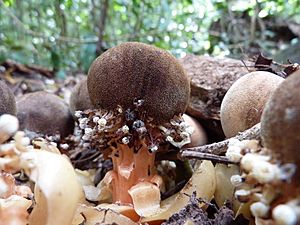Balanophora fungosa facts for kids
Quick facts for kids Balanophora fungosa |
|
|---|---|
 |
|
| B. fungosa growing in rainforest near Kuranda in Far North Queensland. | |
| Scientific classification | |
| Genus: |
Balanophora
|
| Species: |
fungosa
|
Balanophora fungosa, also called fungus root, is a unique flowering plant. It belongs to the family Balanophoraceae. You can find it in South Asia, Southeast Asia, Australia, and some Pacific Islands. This plant is an obligate parasite. This means it must grow on the roots of other plants to survive. It gets all its food from rainforest trees. The part that flowers looks like a puffball mushroom. But it's actually a round shape covered with thousands of tiny female flowers. At the bottom of this round part, there are a few male flowers. When it blooms, the plant smells a bit like mice!
Contents
What Does Fungus Root Look Like?
Like other plants in its group, Balanophora fungosa is a holoparasite. This means it lives completely off another plant. It has no chlorophyll, which is the green stuff plants use to make their own food from sunlight.
The parts of the plant you can see above the ground are a hard, oddly shaped lump called a tuber. The flowers grow out from this tuber. Its leaves are like small scales. They are a pale cream color. Each leaf is about 8 to 30 millimeters (0.3 to 1.2 inches) long. They are also about 7 to 20 millimeters (0.3 to 0.8 inches) wide. The leaves pretty much wrap around the stem.
Male and Female Flowers
This plant is monoecious. This means it has both male and female flowers on the same plant. Thousands of tiny female flowers cover a round structure. This structure is about 15 to 20 millimeters (0.6 to 0.8 inches) across. The styles (part of the female flower) are very short, less than 1 millimeter long.
About 20 male flowers grow around the bottom of this round part. Each male flower is about 3 to 5 millimeters (0.1 to 0.2 inches) wide. They have a small stalk, called a pedicel, about 5 to 6 millimeters (0.2 inches) long. These male flowers are covered with white, powdery pollen.
How Was Fungus Root Named?
Balanophora fungosa was first described in 1774. Two scientists, Johann Reinhold Forster and Georg Forster, gave it its name. They published their description in a book called Characteres Generum Plantarum.
The second part of its name, fungosa, comes from a Latin word. It means "full of holes" or "spongy." This describes how the plant looks.
Different Types of Fungus Root
There are two main types, or subspecies, of Balanophora fungosa:
- Balanophora fungosa subsp. fungosa
- Balanophora fungosa subsp. indica
Where Does Fungus Root Grow?
You can find Balanophora fungosa in coastal forests. It grows from sea level up to about 900 meters (2,950 feet) high. Its home includes Australia, Taiwan, Indonesia, the Ryukyu Islands, New Guinea, the Philippines, some Pacific Islands, India, and Cambodia. In Australia, it grows in Queensland. You can find it from near the border with New South Wales all the way up to Cape York.
How Does Fungus Root Live?
Balanophora fungosa subsp. indica can attach to many different plants. Scientists know of twelve plant species from eight different families that it uses as hosts. These include plants from the groups Syzygium, Olea, and Rapanea. Sometimes, this plant can even become a weed in coffee and tea farms.
Animals That Visit Fungus Root
Many small animals visit the flowers of Balanophora fungosa. These visitors include ants, springtails, flies, and even rats! The rats seem to be drawn to the plant's unique smell. Workers of the Asiatic honeybee, Apis cerana, have been seen collecting pollen from it.
Two types of beetles from the group Lasiodactylus also use the plant. So do a moth from the Pyralidae family and another from the Tipulidae family. These insects use the small leaf-like parts at the base of the flowers as a place to lay their eggs and raise their young.
Is Fungus Root Used as Medicine?
Some groups of people use B. fungosa for traditional medicine. For example, the Paliar people in Tamil Nadu use it to help treat certain health problems.




